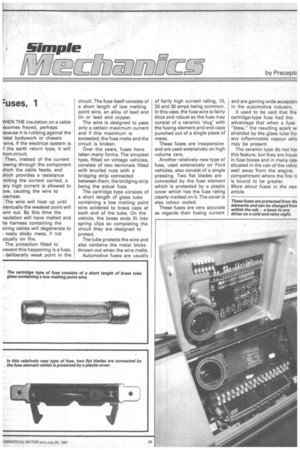:u s e s, 1 by Precept(
Page 31

If you've noticed an error in this article please click here to report it so we can fix it.
VHEN THE insulation on a cable lecomes frayed, perhaps lecause it is rubbing against the letal bodywork or chassis -ame, if the electrical system is If the earth return type, it will hart-circuit.
Then, instead of the current owing through the component which the cable feeds, and which provides a resistance miting the current carried, a ery high current is allowed to low, causing the wire to tverheat.
The wire will heat up until tventually the weakest point will turn out. By this time the lsulation will have melted and he harness containing the viring cables will degenerate to I nasty sticky mess, if not Ictually on fire.
The protection fitted to trevent this happening is a fuse, deliberatly weak point in the circuit. The fuse itself consists of a short length of low melting point wire, an alloy of lead and tin or lead and copper.
The wire is designed to pass only a certain maximum current and if this maximum is exceeded, the fuse melts and the circuit is broken.
Over the years, fuses have taken many forms. The simplest type, fitted on vintage vehicles, consists of two terminals fitted with knurled nuts with a bridging strip connected between them, the bridging strip being the actual fuse.
The cartridge type consists of a short length of glass tube containing a low melting point wire soldered to brass caps at each end of the tube. On the vehicle, the brass ends fit into spring clips so completing the circuit they are designed to protect.
The tube protects the wire and also contains the metal blobs thrown out when the wire melts.
Automotive fuses are usually of fairly high current rating, 10, 20 and 30 amps being common. In this case, the fuse wire is fairly thick and robust so the fuse may consist of a ceramic 'slug' with the fusing element and end caps punched out of a single piece of metal.
• These fuses are inexpensive and are used extensively on high volume cars.
Another relatively new type of fuse, used extensively on Ford vehicles, also consist of a single pressing. Two flat blades are connected by the fuse element which is protected by a plastic cover which has the fuse rating clearly marked on it. The cover is also colour coded.
These fuses are very accurate as regards their fusing current and are gaining wide acceptant in the automotive industry.
It used to be said that the cartridge-type fuse had the advantage that when a fuse "blew," the resulting spark w. shielded by the glass tube fro any inflammable vapour whii may be present.
The ceramic type do not ha\ this feature, but they are haus( in fuse boxes and in many cast situated in the cab of the vehic well away from the engine compartment where the fire ri! is bound to be greater. More about fuses in the flex; article.








































